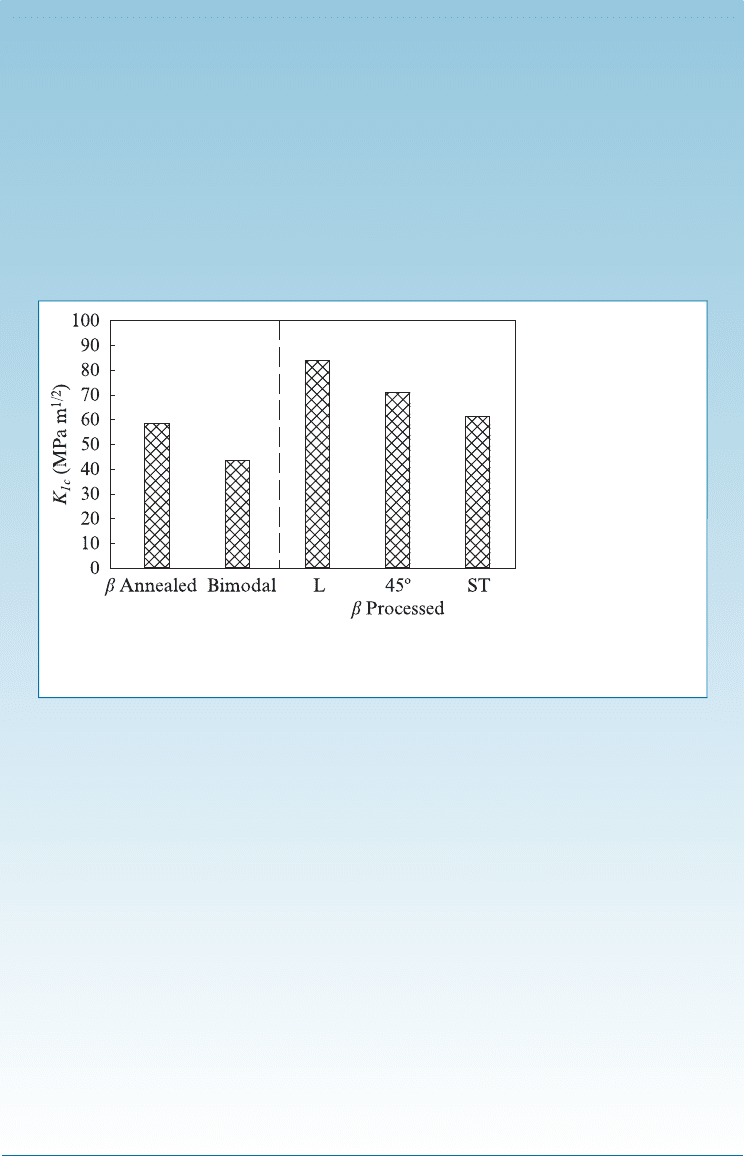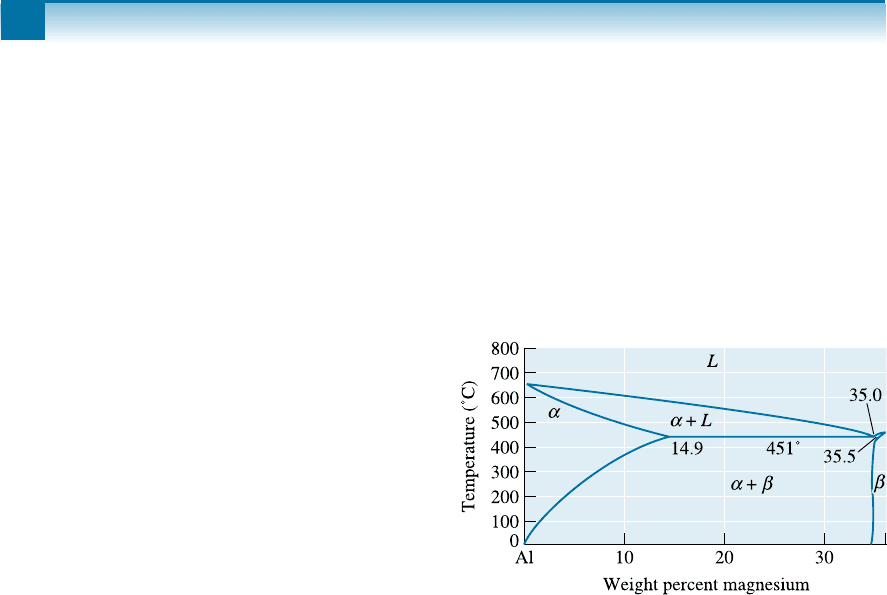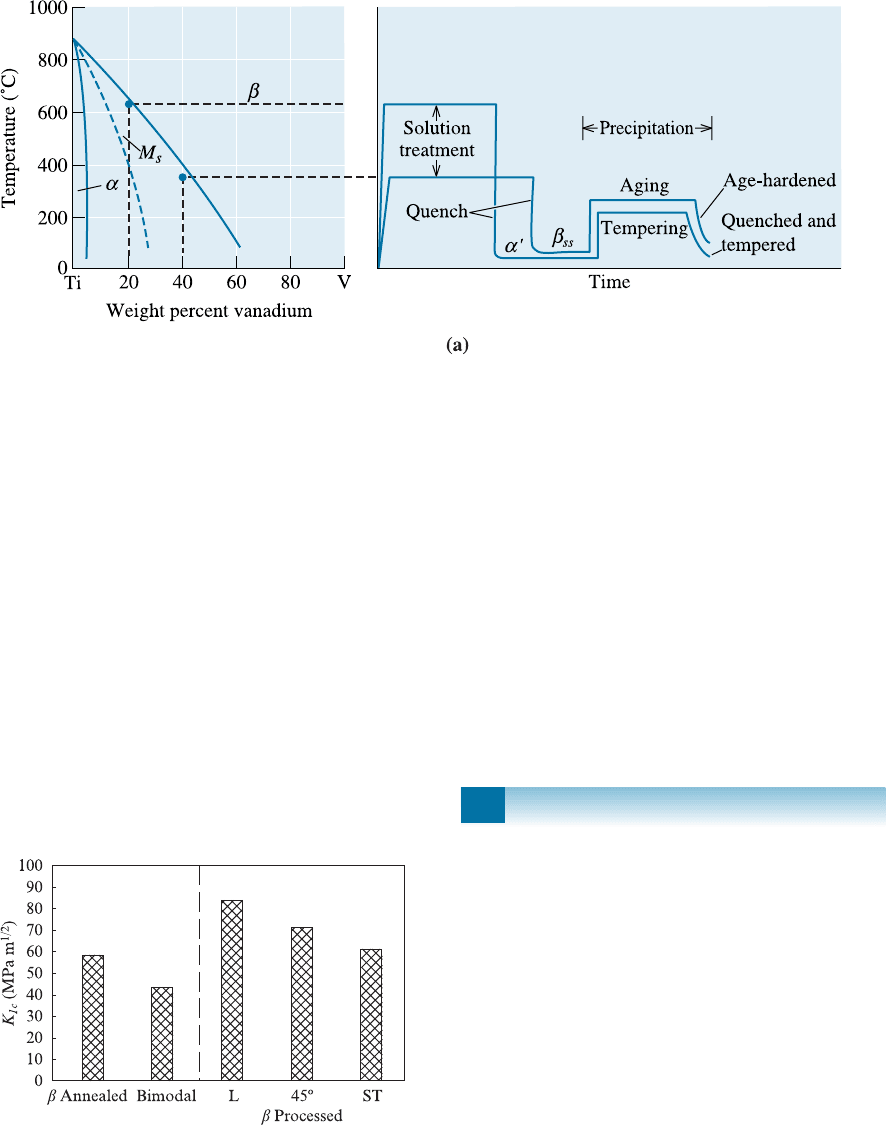Askeland D.R., Fulay P.P. Essentials of Materials Science & Engineering
Подождите немного. Документ загружается.


at the edge of the plate such that after this crack size the crack will grow at a
catastrophic rate. Perform this calculation for the beta annealed titanium and
ST samples. The yield stress of b-annealed, bimodal alloy, b-processed L, and
ST alloys are 1180, 1200, 1275, and 1280 MPa, respectively.
SOLUTION
For the b-annealed structure, the fracture toughness is about 60 MPa m
1=2
(Figure 14-14). From Chapter 7, the plane-strain fracture toughness ðK
Ic
Þ is
given by
K
Ic
¼ f s
ffiffiffiffiffiffiffiffiffiffiffi
p a
p
The value of f is 1.12, since the crack or notch is on the edge of the sample.
Therefore,
60 MPa m
1=2
¼ 1:12 ð200 MPaÞ
ffiffiffiffiffiffiffiffiffiffiffi
p a
p
This gives us a value of a, where the crack size will be 2.28 cm (i.e., any crack
that is larger than about 2.28 cm will grow catast rophically).
For the L sample, the fracture toughness is about 80 MPa m
1=2
.
Therefore, the critical flaw length for a tensile stress of 200 MPa will be given
by
80 MPa m
1=2
¼ 1:12 ð200 MPaÞ
ffiffiffiffiffiffiffiffiffiffiffi
p a
p
This works out to about 4 cm. Thus, the L sample titanium alloy with its higher
fracture toughness will be able to withstand a much larger sized crack before
the crack will grow catastrophically.
Later in Chapter 15 we will see that ceramic materials have much lower
fracture toughness, so that the critical flaw size is very small compared to that
for titanium and other alloys with very high fracture toughness.
Figure 14-14 Fracture Toughness of Titanium 6246 Alloy. (Source: Titanium,
2007, page 309, K.U. Kainer, Gerd Lutjering and James C. Williams, Figure 7.27.
With kind permission of Springer Science and Business Media.)
CHAPTER 14 Nonferrous Alloys460

EXAMPLE 14-9 Design of a Connecting Rod
Design a high-performance connecting rod for the engine of a racing auto-
mobile (Figure 14-15).
SOLUTION
A high-performance racing engine requires materials that can operate at high
temperatures and stresses while minimizing the weight of the engine. In normal
automobiles, the connecting rods are often a forg ed steel or a malleable cast
iron. We might be able to save considerable weight by replacing these parts
with titanium.
To achieve high strengths, we might consider an alpha-beta titanium alloy.
Because of its availability, the Ti-6% Al-4% V alloy is a good choice. The alloy
is heated to about 1065
C, which is in the all-b portion of the phase diagram.
On quenching, a titanium martensite forms; subsequent tempering produces a
microstructure containing b precipitates in an a matrix.
When the heat treatment is performed in the all-b region, the tempered
martensite has an acicular structure, which reduces the rate of growth of any
fatigue cracks that might develop.
Figure 14-15
Sketch of connecting rod (for Example
14-9).
EXAMPLE 14-10 Materials for Hip Prosthesis
What type of a material would you choo se for an implant to be used for a total
hip replacement implant?
SOLUTION
A hip prosthesis is intended to replace part of the worn out or damaged femur
bone. The implant has a metal head and fits down the cavity of the femur. We
need to consider the following factors: biocompatibility, corrosion resistance,
high-fracture toughness, excellent fatigue life (so that implants last for many
years since it is di‰cult to do the surgery as patients get older), and wear re-
sistance. We also need to consider the sti¤ness. If the alloy chosen is too sti¤
compared to the bone, most of the stress will be carried by the implant. This
leads to weakening of the remaining bone and, in turn, can make the implant
loose. Thus, we need a material that has a high tensile strength, corrosion re-
sistance, biocompatibility, and fracture toughness. These requirements suggest
316 stainless steel or Ti-6%Al-4% V. Neither of these materials are magnetic
and both are opaque to x-rays. This means no interference for magnetic reso-
nance and x-ray imaging. Titanium alloys are not very hard and can wear out.
Stainless steels are harder, but they are much sti¤er than bone. Titanium is
14-5 Titanium Alloys 461

biocompatible and would be a better choice. Perhaps a composite material in
which the stem is made from a Ti-6%Al-4% V alloy and a head that is made
from a wear-resistant, corrosion resistant, and fractured tough ceramic, such as
alumina, may be an answer. The inside of the socket could be made from an
ultra-high-density (ultra-high molecular weight) polyethylene that has a very
low-friction coe‰cient. The surface of the implant could be made porous so as
to encourage the bone to grow. Another option is to coat the implant with a
material like porous hydroxyapatite to encourage bone growth.
14-6 Refractory and Precious Metals
The refractory metals, which include tungsten, molybdenum, tantal um, and niobium
(or columbium), have exceptionally high-melting temperatures (above 1925
C) and,
consequently, have the pot ential for high-temperatu re service. Applications include
filaments for light bulbs, rocket nozzles, nuclear power generators, tantalum- and
niobium-based electronic capacitors, and chemical processing equipment. These metals,
however, have a high density, limiting their specific strengths (Table 14-10).
Oxidation The refractory metals begin to oxidize between 200 and 425
C and are
rapidly contaminated or embrittled. Consequently, special precautions are required
during casting, hot working, welding, or powder metallurgy. The metals must also be
protected during service at elevated temperatures. For example, the tungsten filament in
a light bulb is protected by a vacuum.
For some applications, the metals may be coated with a silicide or aluminide coat-
ing. The coating must (a) have a high melting temperature, (b) be compatible with the
refractory metal, (c) provide a di¤usion barrier to prevent contaminants from reaching
the underlying metal, and (d) have a coe‰cient of thermal expansion similar to that of
the refractory metal. Coating s are available that protect the metal to about 1650
C. In
some applications, such as capacitors for cellular phones, the formation of oxides is
useful since we want to make use of the oxide as a nonconducting material.
Forming Characteristics The refractory metals, which have the BCC crystal structure,
display a ductile-to-brittle transition temperature. Because the transition temperatures
TABLE 14-10 9 Properties of some refractory metals
T F 1000
˚
C
Melting Tensile Yield Transition
Temperature Density Strength Strength Temperature
Metal (
˚
C) (g/cm
3
) (MPa) (MPa) (
˚
C)
Nb 2468 8.57 117 55 140
Mo 2610 10.22 345 207 30
Ta 2996 16.6 186 166 270
W 3410 19.25 455 103 300
CHAPTER 14 Nonferrous Alloys462

for niobium and tantalum are well below room temperature (Table 14-10), these two
metals can readily be formed. However, annealed molybdenum and tungsten normally
have a transition temperature above room temperature, causing them to be brittle at
room temperature. Fortunately, if these metals are hot worked to produce a fibrous
microstructure, the transition temperature is lowered and the forming characteristics
are improved.
Alloys Large increases in both room-temperature and high-temperature mechanical
properties are obtained by alloying. Tungsten alloyed with hafnium, rhenium, and car-
bon can operate up to 2100
C. These alloys typically are solid-solution strengthened;
in fact, tungsten and molybdenum form a complete series of solid solutions, much
like copper and nickel. Some alloys, such as W-2% ThO
2
, are dispersion strengthened
by oxide particles during their manufacture by powder metallurgy processes. Com-
posite materials, such as niobium reinforced with tungsten fibers, may also improve
high-temperature properties.
Precious Metals These include gold (Au), silver (Ag), palladium (Pd), platinum (Pt),
and rhodium (Rh). As their name suggests, these are precious and expensive. From an
engineering viewpoint, these materials resist corrosion and make conductors of elec-
tricity. As a result, alloys of these materials are often used as electrodes for devices.
These electrodes are formed using a thin-film deposition (e.g., sputtering or electro-
plating) or screen printing of metal powder dispersions/pastes. Nano-sized particles of
Pt/Rh/Pd (loaded onto a ceramic support) are also used as catalysts in automobiles.
These metals facilitate the oxidation of CO to CO
2
and NO
x
to N
2
and O
2
. They are
also used as catalysts in petroleum refining.
SUMMARY
V The ‘‘light metals’’ include low-density alloys based on aluminum, magnesium, and
beryllium. Aluminum alloys have a high specific strength due to their low density
and, as a result, find many aerospace applications. Excellent corrosion resistance
and electrical conductivity of aluminum also provide for a vast number of applica-
tions. Aluminum and magnesium are limited to use at low temperatures because of
the loss of their mechanical properties as a result of overaging or recrystallization.
Copper alloys (brasses and bronzes) are also used in many structural and other
applications. Titanium alloys have intermediate densities and temperature resist-
ance, along with excellent corrosion resistance, leading to applications in aerospace,
chemical processing, and biomedical devices.
V Nickel and cobalt alloys, including superalloys, provide good properties at even
higher temperatures. Combined with their good corrosion resistance, these alloys
find many applications in aircraft engines and chemical processing equipment.
GLOSSARY
Bioactive A material that is not rejected by the human body and eventually becomes part of the
body (e.g., hydroxyapatite).
Biocompatible A material that is not rejected by the human body.
Blister copper An impure form of copper obtained during the copper refining process.
Glossary 463

Brass A group of copper-based alloys, normally containing zinc as the major alloying element.
Bronze Generally, copper alloys containing tin but can contain other elements.
Castability The ease with which a metal can be poured into a mold to make a casting without
producing defects or requiring unusual or expensive techniques to prevent casting problems.
Fluidity The ability of liquid metal to fill a mold cavity without prematurely freezing.
Monel The copper-nickel alloy, containing approximately 60% Ni, that gives the maximum
strength in the binary alloy system.
Nonferrous alloy An alloy based on some metal other than iron.
Refractory metals Metals having a melting temperature above 1925
C.
Specific strength The ratio of strength to density. Also called the strength-to-weight ratio.
Superalloys A group of nickel, iron-nickel, and cobalt-based alloys that have exceptional heat
resistance, creep resistance, and corrosion resistance.
Temper designation A shorthand notation using letters and numbers to describe the processing
of an alloy. H tempers refer to cold-worked alloys; T tempers refer to age-hardening treatments.
Wrought alloys Alloys that are shaped by a deformation process.
PROBLEMS
3
14-1 In some cases, we may be more interested in cost
per unit volume than in cost per unit weight.
Rework Table 14-1 to show the cost in terms of
$/cm
3
. Does this change/alter the relationship
between the di¤erent materials?
Section 14-1 Aluminum Alloys
14-2 Assuming that the density remains unchanged,
compare the specific strength of the 2090-T6 alu-
minum alloy to that of a die-cast 443-F alumi-
num alloy. If you considered the actual density,
do you think the di¤erence between the specific
strengths would increase or become smaller?
Explain.
14-3 Explain why aluminum alloys containing more
than about 15% Mg are not used.
14-4 Would you expect a 2024-T9 aluminum alloy
to be stronger or weaker than a 2024-T6 alloy?
Explain.
14-5 Estimate the tensile strength expected for the fol-
lowing aluminum alloys:
(a) 1100-H14 (b) 5182-H12 (c) 3004-H16
14-6 Suppose, by rapid solidification from the liquid
state, that a supersaturated Al-7% Li alloy can be
produced and subsequently aged. Compare the
amount of b that will form in this alloy with that
formed in a 2090 alloy.
14-7 Determine the amount of Mg
2
Al
3
(b) expected
to form in a 5182-O aluminum alloy (See Figure
14-2).
14-8 Based on the phase diagrams, which of the fol-
lowing alloys would be most suited for thixocast-
ing? Explain your answer. (See Figure 14-2 and
phase diagrams from Chapters 11 and 12.)
(a) Al-12% Si (b) Al-1% Cu (c) Al-10% Mg
Figure 14-2 (Repeated for Problems 14-7 and 14-8)
Portion of the aluminum-magnesium phase diagram.
CHAPTER 14 Nonferrous Alloys464

Section 14-2 Magnesium and Beryllium Alloys
14-9 From the data in Table 14-6, estimate the ratio
by which the yield strength of magnesium can
be increased by alloying and heat treatment and
compare with that of aluminum alloys.
14-10 Suppose a 60-cm-long round bar is to support a
load of 181 kg without any permanent deforma-
tion. Calculate the minimum diameter of the
bar if it is made of
(a) AZ80A-T5 magnesium alloy, and
(b) 6061-T6 aluminum alloy.
Calculate the weight of the bar and the approx-
imate cost (based on pure Al and Mg) in each
case.
14-11 A 10-m rod 0.5 cm in diameter must elongate
no more than 2 mm under load. Determine the
maximum force that can be applied if the rod is
made of:
(a) aluminum (b) magnesium (c) beryllium
14-12 For the Mg alloy AZ91, calculate the grain size
from the Hall-Petch equation for a casting that
had strength of 250 MPa (See Example 14-4).
Section 14-3 Copper Alloys
14-13 (a) Explain how pure copper is made. (b) What
are some of the important properties of copper?
(c) What is brass? (d) What is bronze? (e) Why
does the Statue of Liberty appear green?
14-14 We say that copper can contain up to 40% Zn
or 9% Al and still be single phase. How do we
explain this statement in view of the phase dia-
grams for the Cu-Zn system? [See Figure 14-6(a).]
14-15 Compare the percentage increase in the yield
strength of commercially pure annealed alumi-
num, magnesium, and copper by strain harden-
ing. Explain the di¤erences observed.
14-16 We would like to produce a quenched and
tempered aluminum bronze containing 13% Al.
Recommend a heat treatment, including appro-
priate temperatures. Calculate the amount of
each phase after each step of the treatment.
14-17 A number of casting alloys have very high lead
contents; however, the Pb content in wrought
alloys is comparatively low. Why isn’t more
lead added to the wrought alloys? What pre-
cautions must be taken when a leaded wrought
alloy is hot worked or heat treated?
14-18 Would you expect the fracture toughness of
quenched and tempered aluminum bronze to be
high or low? Would there be a di¤erence in the
resistance of the alloy to crack nucleation com-
pared with crack growth? Explain.
Section 14-4 Nickel and Cobalt Alloys
14-19 Based on the photomicrograph in Figure 14-8(a),
would you expect the g
0
precipitate or the car-
bides to provide a greater strengthening e¤ect in
superalloys at low temperatures? Explain.
14-20 The density of Ni
3
Al is 7.5 g/cm
3
. Suppose a
Ni-5 wt% Al alloy is heat treated so that all of
the aluminum reacts with nickel to produce
Ni
3
Al. Determine the volume percentage of
the Ni
3
Al precipitate in the nickel matrix.
Section 14-5 Titanium Alloys
14-21 When steel is joined using arc welding, only the
liquid fusion zone must be protected by a gas
or flux. However, when titanium is welded, both
the front and back sides of the welded metal
must be protected. Why must these extra pre-
cautions be taken when joining titanium?
14-22 Both a Ti-15% V alloy and a Ti-35% V alloy
are heated to a temperature at which all b just
forms. They are then quenched and reheated
to 300
C. Describe the changes in microstruc-
ture during the heat treatment for each alloy,
including the amount of each phase. What is
the matrix and what is the precipitate in each
case? Which is an age-hardening process?
Which is a quench and temper process? [See
Figure 14-13(a)].
Figure 14-8 (Repeated for Problem 14-19)
(a) Microstructure of a superalloy, with carbides at
the grain boundaries and g
0
precipitates in the matrix
(15,000).
Problems 465

14-23 Determine the specific strength of the strongest
Al, Mg, Cu, Ti, and Ni alloys. Use the densities
of the pure metals in your calculations. Try to
explain their order.
14-24 Based on the phase diagrams, estimate the sol-
ubilities of Ni, Zn, Al, Sn, and Be in copper
at room temperature. Are these solubilities
expected in view of Hume-Rothery’s conditions
for solid solubility (Chapter 10)? Explain.
14-25 A titanium 6246 alloy plate of ST type was
found to have an edge crack of size 3 mm. What
will be the highest level of tensile stress ðsÞ that
can be supported on this plate without causing
catastrophic failure? [See Figure 14-14.]
14-26 A titanium 6246 alloy plate of a bimodal mi-
crostructure was found to have an edge crack of
size 4 mm. What will be the highest level of
tensile stress ðsÞ that can be supported on this
plate without causing catastrophic failure? [See
Figure 14-14.]
Section 14-6 Refractory and Precious Metals
14-27 What is a refractory metal or an alloy? What is
a precious metal?
14-28 The temperature of a coated tungsten part is
increased. What happens when the protective
coating on a tungsten part expands more than
the tungsten? What happens when the protective
coating on a tungsten part expands less than the
tungsten?
14-29 For what applications are Pt, Rh, Pd, Ag used?
Design Problems
g
14-30 A part for an engine mount for a private air-
craft must occupy a volume of 60 cm
3
with a
minimum thickness of 0.5 cm and a minimum
width of 4 cm. The load on the part during
service may be as much as 75,000 N. The part is
expected to remain below 100
C during service.
Design a material and its treatment that will
perform satisfactorily in this application.
14-31 You wish to design the rung on a ladder. The
ladder should be light in weight so that it can be
easily transported and used. The rungs on the
ladder should be 0.625 cm 2:5 cm and are
30 cm long. Design a material and its processing
for the rungs.
14-32 We have determined that we need an alloy
having a density of 2:3 G 0:05 g/cm
3
that must
Figure 14-13 (Repeated for Problem 14-22) (a) Heat treatment of the alpha-beta titanium alloys.
Figure 14-14 (Repeated for Problems 14-25 and
14-26) Fracture Toughness of Titanium 6246 Alloy.
(Source: Titanium, Lutjering, G. and Williams, J.C.,
Figure 7.27, p. 309.)
CHAPTER 14 Nonferrous Alloys466
be strong, yet still have some ductility. Design a
material and its processing that might meet
these requirements.
14-33 We wish to design a mounting device that will
position and aim a laser for precision cutting of
a composite material. What design requirements
might be important? Design a material and its
processing that might meet these requirements.
14-34 Design a nickel-titanium alloy that will produce
60 volume percent Ni
3
Ti precipitate in a pure-
nickel matrix.
14-35 An actuating lever in an electrical device must
open and close almost instantly and carry a
high current when closed. What design require-
ments would be important for this application?
Design a material and its processing to meet
these requirements.
14-36 A fan blade in a chemical plant must operate
at temperatures as high as 400
C under rather
corrosive conditions. Occasionally, solid mate-
rial is ingested and impacts the fan. What design
requirements would be important? Design a
material and its processing for this application.
Problems 467

15
Ceramic Materials
Have You Ever Wondered?
9 What is the magnetic strip on a credit card made from?
9 What material is used to protect the space shuttl e from high temperatures during re-entry?
9 What ceramic material is commonly added to paints?
9 What ceramic material is found in bone and teeth?
9 What are spark plugs made from?
The goal of this chapter is to examine more
closely the synthesis, processing, and applica-
tions of ceramic materials. Ceramics have been
used for many thousands of years. Most ceramics
exhibit good strength under compression; how-
ever, typically they exhibit virtuall y no ductility
under tension. The family of ceramic materials
includes polycrystalline and single-crystal in-
organic materials, amorphous inorganic glasses,
and glass-ceramics.
In Chapters 2 and 3, we learned about the
bonding in ceramic materials, the crystal struc-
tures of technologica lly useful ceramics, and the
arrangements of ions in glasses.
468

This chapter focuses on the synthesis, pro-
cessing, and applicatio ns of ceramics. We will
also recapitulate the processing and applications
of inorganic glasses and glass-ceramics. We be-
gin with a discussion that summarizes the classi-
fication and applications of ceramics.
15-1 Applications of Ceramics
One way to classify ceramics is based on their class of chemical compounds
(e.g., oxides, carbides, nitrides, sulfides, fluorides, etc.). Another way, which we will use
here, is to classify ceramics by their major function.
Ceramics are used in a wide range of technologies such as refractories, spark plugs,
dielectrics in capacitors, sensors, abrasives, magnetic recording media, etc. The space
shuttle makes use of @25,000 reusable, lightweight, highly porous ceramic tiles that
protect the aluminum frame from the heat generated during re-entry into the Earth’s
atmosphere. These tiles are made from high-purity silica fibers and colloidal silica
coated with a borosilicate glass. Ceramics also appear in nature as oxides and in natural
materials; the human body has the amazing ability of making hydroxyapatite, a ce-
ramic found in bones and teeth. Ceramics are also used as coatings. Glazes are ceramic
coatings applied to glass objects; enamels are ceramic coatings applied to metallic ob-
jects. Let’s follow the classification shown in Table 15-1 and take note of di¤erent ap-
plications. Alumina and silica are the most widely used ceramic materials and, as you
will notice, there are numerous applications listed in Table 15-1 that depend upon the
use of these two ceramics.
The following is a brief summary of applications of some of the more widely used
ceramic materials:
9
Alumina (Al
2
O
3
) is used to contain molten metal or in applications where a
material must operate at high temperatures, but where high strength is also required.
Alumina is also used as a low dielectric constant substrate for electronic packaging that
houses silicon chips. One classical application is for insulators in spark plugs. Some
unique applications are also being found in dental and medical use. Chromium-doped
alumina is used for making lasers. Fine particles of alumina are used as catalyst
supports.
9
Diamond (C) is the hardest naturally occurring material. Industrial diamonds are
used as abrasives for grinding and polishing . Diamond and diamond-like coatings pre-
pared using chemical vapor deposition processes are used to make abrasion-resistant
coatings for many di¤erent applications (e.g., cutting tools). It is, of course, also used in
jewelry.
9
Silica (SiO
2
) is probably the most widely used ceramic material. Silica is an
essential ingredient in glasses and many glass ceramics. Silica-based materials are used
in thermal insulation, refractories, abrasives, fiber-reinforced composites, laboratory
glassware, etc. In the form of long continuous fibers, silica is used to make optical fibers
for communications. Powders made using fine particles of silica are used in tires, paints,
and many other applications.
9
Silicon carbide (SiC) provides outstanding oxidation resistance at tempera-
tures even above the melting point of steel. SiC often is used as a coating for metals,
15-1 Applications of Ceramics 469
